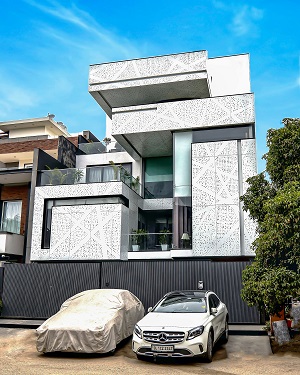Robin Sisodiya graduated from the University of School of Architecture and Planning, New Delhi in 2010. Post his graduation, he worked for 6 months before deciding to go independent. It was during his work as an architect with another firm when he realised that architecture had quickly become his passion. After gaining professional work experience, he later started taking up projects in partnership and successfully worked on multiple projects in Delhi-NCR. The whole experience inspired him with a desire to start his own design firm. With the intent to bring a fresh design perspective and a comfortable yet eco friendly environment, he laid the foundation of ASRO Arcade in 2014. It is now a rapidly developing architecture and interior design firm in Gurgaon and Delhi NCR.

The architectural facade, an inevitable part of any building, has long been a compelling focus of interest for architects and designers combining attributes of both appearance and performance in a holistic manner. Facades, as the building envelope, form the outer skins of buildings, as a projected image and creative intent of an architect or a designer. Increasingly, in the current scenario of climatic change, facades are also observed as significant environmental moderators. A thoughtfully designed skin can make a building work more efficiently and effectively for its occupants as well as for the environment, transforming the building’s performance. In this article, Ar. Robin Sisodiya, Founder and Principal Architect of ASRO Arcade India explains the evolution of facade design and its significance in 21st-century buildings.
A sense of identity: A facade gives a unique form to the building that creates an iconic image in the context. Never before have the facades been as challenged to be innovative and distinctive as it is now, which gives the architect an admiration to present a unique and tasteful design. There has been a perceptible shift from the traditional monotonous facade design towards strikingly distinct facade trends in every structure. A building’s facade has become a tool to simultaneously express the users’ and the designer’s personalities. An appealing and smart building exterior is known to make the building stand out from neighbouring structures while responding to the local context.
A layer of Protection: The technological advancements have offered access to a wide range of building materials, design concepts, and architectural know-how, to construct a strong facade system with better security. A facade has the potential to influence the fresh air and light entering the structure, therefore impacting the user’s comfort and well-being. Both residential and commercial building facades establish the personality and aesthetics of the structure. Not only is it leaves a great opportunity to show off the character of the structure, but it also helps shield it from bad weather and other elements, like acoustics, energy, and light. A facade displays a distinct character since it serves as an interactive medium between interior and exterior.
A significant contributor to Energy efficiency: Energy efficiency has become more essential and there is an immediate need to conserve energy as it is being depleted at a faster rate than ever before in the twenty-first century. The exterior of a building plays a crucial role in energy efficiency apart from the factor of aesthetic appeal. Facades can significantly lower energy expenditures by minimizing solar exposure and lowering the building’s energy needs. Besides beauty and comfort, any façade design should take into account the environmental concerns and surroundings as a whole. An effective facade design is one that considers the solar gain and cooling loads of a building, thus contributing to energy efficiency.
Influence of technology on Facades: From smart materials to parametric forms, technology is constantly influencing the perception of architects and designers on facades. As sustainable design has evolved from a trending fashion to a ‘golden rule’, facades have turned into eco-sensitive entities of a building. High-performance glazing systems enhance the thermal performance of facade systems by inserting a ‘transparent’ insulator between glass panes in order to provide a good thermal break to minimise thermal conductance. Double skin facades lower the indoor temperatures reducing the need for and cooling load of air-conditioning. The emergence of kinetic facade technologies has substantially reinforced energy efficiency, especially in hot climatic regions.
As facade systems continue to evolve in complexity, the role of it forming a robust future makes it an integral part of every structure, rather than an aesthetic factor. With new innovations in materials, design, and ideas, facade design is continuing to unlock several opportunities for the future built environment.


